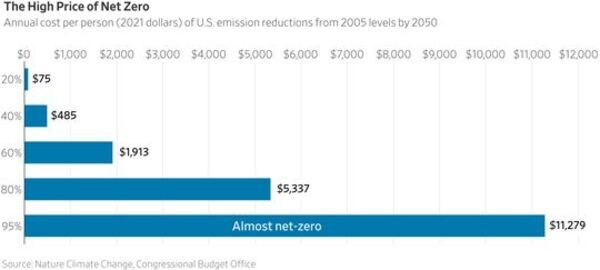The annual cost of the promises to which President Obama signed on under the Paris climate agreement would have hit roughly $50 billion in 2030, or about $140 per person. Many studies show Americans are willing to pay a couple of hundred dollars a year to remedy climate change, but this data is highly skewed by a small minority willing to spend thousands of dollars. A recent Washington Post survey found that a majority of Americans would vote against a $24 annual climate tax on their electricity bills. Even if they'd hand over $140, it'd buy them little. If Mr. Obama's agreement were sustained through 2100, it would reduce global temperatures by a minuscule 0.06 degree Fahrenheit.
President Biden is pushing much stronger climate policies with much higher price tags. Before his election, he promised to spend $2 trillion over four years on climate policies — equivalent to $1,500 per person per year. And Mr. Biden's current promise — 100% carbon emission reduction by 2050 — will be even more phenomenally expensive.
A new study in Nature finds that a 95% reduction in American carbon emissions by 2050 will annually cost 11.9% of U.S. gross domestic product. To put that in perspective: Total expenditure on Social Security, Medicare and Medicaid came to 11.6% of GDP in 2019. The annual cost of trying to hit Mr. Biden's target will rise to $4.4 trillion by 2050. That's more than everything the federal government is projected to take in this year in tax revenue. It breaks down to $11,300 per person per year, or almost 500 times more than what a majority of Americans is willing to pay.
Although the U.S. is the world's second-largest emitter of greenhouse gasses right now, America's reaching net zero would matter little for the global temperature. If the whole country went carbon-neutral tomorrow, the standard United Nations climate model shows the difference by the end of the century would be a barely noticeable reduction in temperature of 0.3 degree Fahrenheit. This is because the U.S. will make up an ever-smaller share of emissions as the populations of China, India and Africa grow and get richer.
As Indian Power Minister Raj Kumar Singh blurted out during a recent climate confab, net zero is a "pie in the sky," and "you can't stop" developing countries from using more and more fossil fuels. A realistic climate solution would instead focus on innovation to bring down the price of cleaner energy to one both American and Indian voters are willing to pay.
Mr. Lomborg is president of the Copenhagen Consensus and a visiting fellow at the Hoover Institution. His latest book is "False Alarm: How Climate Change Panic Costs Us Trillions, Hurts the Poor, and Fails to Fix the Planet."




Pun intended.